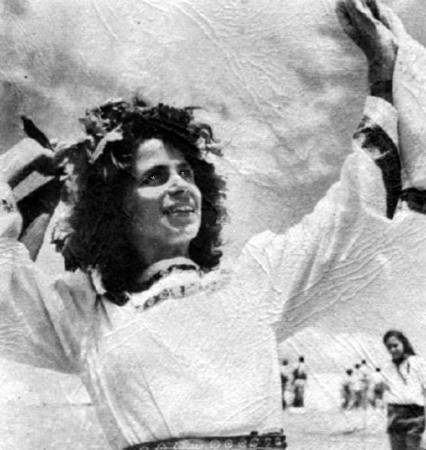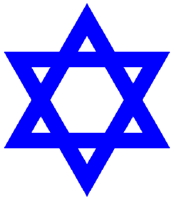
|
The Society of Folk Dance Historians (SFDH)
Folk Dance of Israel
[
Home |
About |
Encyclopedia | CLICK AN IMAGE TO ENLARGE |

|
Summary of an article on the occasion of the 1968 Dalya Festival.

 In the field of dance, looking back for sources and roots in ancient times, to the great creative period of Israeli national life, we find that in Biblical times, the Hebrews were a dance-loving people. There is ample proof of this in many of the tales in the Bible.
In the field of dance, looking back for sources and roots in ancient times, to the great creative period of Israeli national life, we find that in Biblical times, the Hebrews were a dance-loving people. There is ample proof of this in many of the tales in the Bible.
Miriam, sister of Moses, led the daughters of Israel in triumphant dance to the accompaniment of cymbals and drums after crossing the Red Sea. The young daughter of the Judge, Jeptha, danced in honor of her father's victory, toward her tragic fate. King David danced before the Ark of the Covenant when it was brought from Shiloh to Jerusalem . . .
More than thirty different words for dance movements have been found in the Bible and Talmud, though their exact meanings are not always known. The Biblical dances cannot be authentically reconstructed as may be the old Egyptian and Greek dances because no paintings, no engravings, no sculptures of human bodies from Biblical times are to be found . . . "Thou shalt not make a graven image nor any manner of likeness . . ." Revival of Biblical dances is therefore a matter of sheer imagination without any claims to authenticity.
One group that must be especially mentioned is the Chassidic sect that developed among Eastern Jews in the 18th century. Their fervent and ecstatic worship of God expresses itself in joyous and multicolored songs and dances. Most of their dances are of ecstatic religious character. One of their dances, the Sher, in a quadrille formation, is well known to folk dancers in Europe and America – it is in particular favor in Israel, especially as a wedding dance.
Another outstanding dance-loving group are the Yemenite Jews, who for many centuries lived in the primitive Arab kingdom of Yemen in southern Arabia, near the Gulf of Aden. All of them have now been returned to Israel, and are probably Israel's most gifted ethnic group in respect to song, dance, natural dramatic expression, and the crafts –l silverwork, embroidery, basket weaving – with a style of their own that is, naturally, very Oriental. In their dances, this style is expressed by restrained leg movements, tiny steps, intense body movements (especially of the limbs), vibration of the knee and ankle, and stylized and expressive hands and arms.
These are the main sources for the revival of Jewish folk dances in Israel, obviously little enough to go on. Biblical dances have not been preserved; Chassidic dances are too ecstatically religious for daily use; Yemenite dances too Oriental for general use. Therefore, the objective of the folk dance movement in Israel could not be, as in other nations, a mere revival of ancient folk forms, but the creation of new ones. The process of creation is now in full swing. Elements of all of these sources blend and become integrated into the new developing dances that grow out of the landscape, out of the soil, out of the work and toil – the enthusiastic devotion and joy in upbuilding the new-old homeland. So impetuous is the tempo and rhythm of this upbuilding that it accelerates and concentrates into years what generally takes centuries – the development of agriculture – of a new type of society based on collective co-operation – and of an indigenous folk culture.
The new dances are mainly the fruit of the years since Israel's independence. There had always been much vivid dancing, ever since the earliest pioneers came to Palestine around and even before 1900. Those who came before and after the first World War brought with them the dances of their former homelands that spread throughout the country – the Hora that came from Romania but changed so considerably in the course of the years that it may now be called an Israeli dance; the Krakowiak from Poland; the Cherkessia from the Caucasus mountains; Alexandrovska from Russia; Polkas from Lithuania; etc. But, as the people became more conscious of self and the second generation grew up, there also grew the urge for indigenous dances of their own.
These were dances that sprang out of the sheer joy of movement – work dances grown out of sowing and reaping; out of shepherd's and fishermen's movements; dances celebrating the finding of a water well and life-giving water; and holiday dances (especially those for the revived ancient Biblical festivals connected with nature and agriculture); tree planting; sheep shearing, and vineyards' festivals.
Thus, elements and influences stemming from Chassidic and Yemenite traditions, from the energetic dances of the Balkans, from the Arab Debkas – dances in open lines with tiny, restrained, sometimes intricate steps and vibrating body movements – are interwoven with step patterns, movements, and group formations of our own, to create a new and interesting style. A synthesis between Orient and Occident is developing – as Israel is, by its geographical position, a bridge between both.
The same type of development is to be found in the music that is connected with the dances. As to the accompaniment, we are still at the beginning and in an experimental stage. Knowing that complex Occidental harmonic instruments, such as, piano, accordion, and guitar, are not suitable for Oriental melodies, we seek other ways to accompany our dances, perhaps in the direction of voice, flute, and percussion instruments.
We also are at the very early stage of developing our dance costumes that could be a national dress for holidays in our rural settlements and villages. We look for a style that combines Biblical and modern trends and fits into our landscape. But it seems to be still more difficult to "create" a folk costume and to make people really wear it than to make people dance new folk dances.
This very process of creating and spreading new folk dances within a short time may seem unnatural, unconvincing, even detestable in the eyes of other nations that, luckier than we were, kept their unbroken folk tradition through the centuries. But, we have no choice. We cannot wait a hundred years for the slow growing of our folk arts – we ned them now, in our day!
DOCUMENTS
- Arabs, a culture.
- Jews, a culture.
- Yemenite Dancing, an article.
- Yemenite Jewish Dance, an article.
Courtesy of the Israel Government Tourist Board.
Printed in Folk Dance Scene, May 1973.
This page © 2018 by Ron Houston.
Please do not copy any part of this page without including this copyright notice.
Please do not copy small portions out of context.
Please do not copy large portions without permission from Ron Houston.